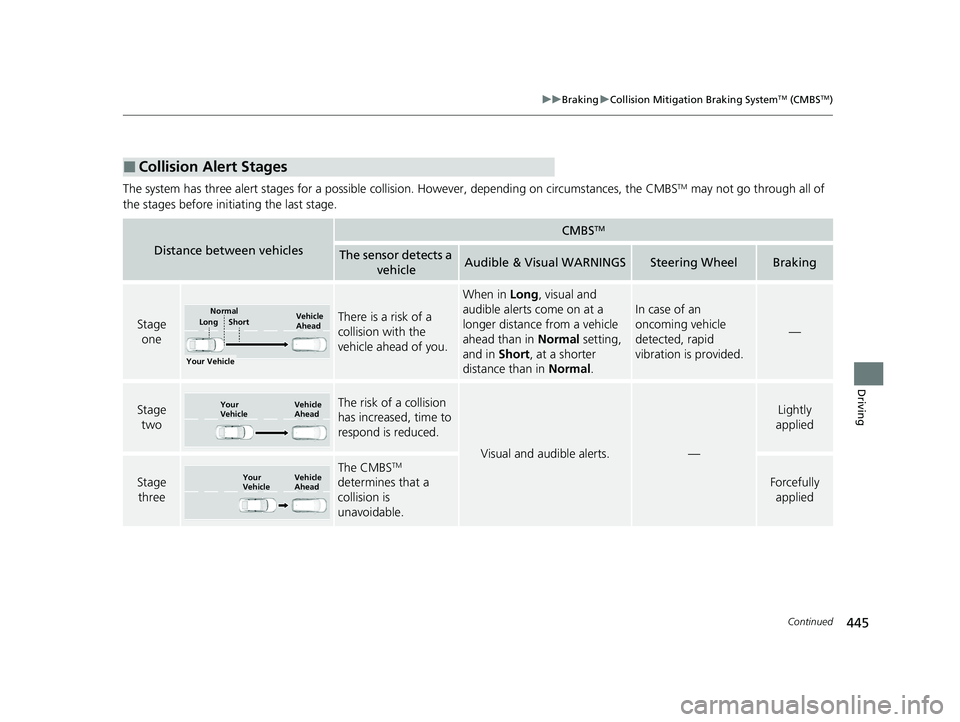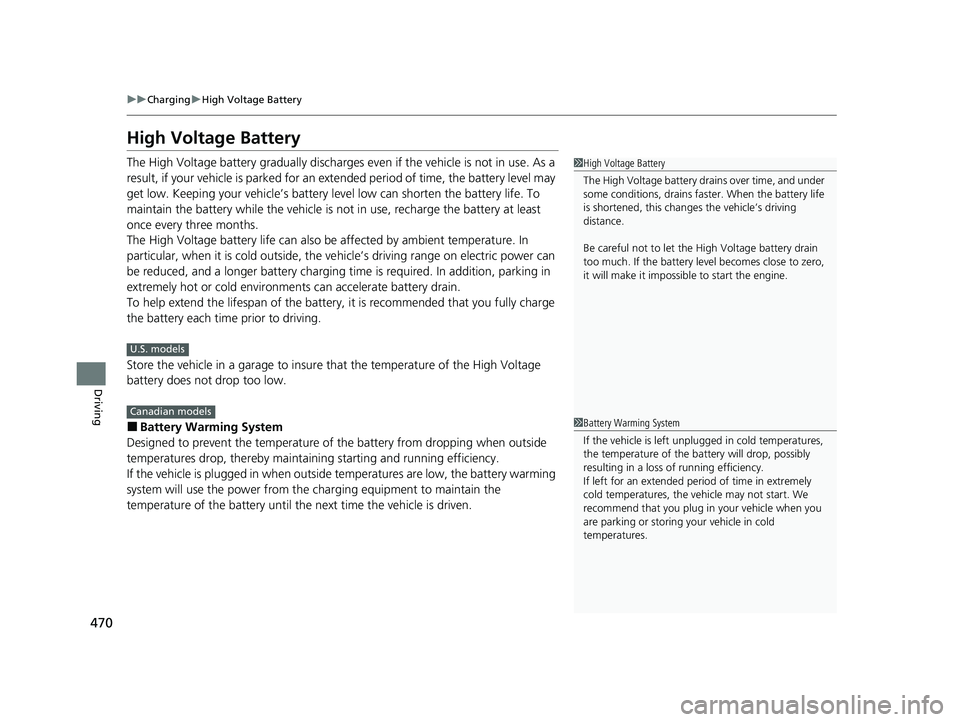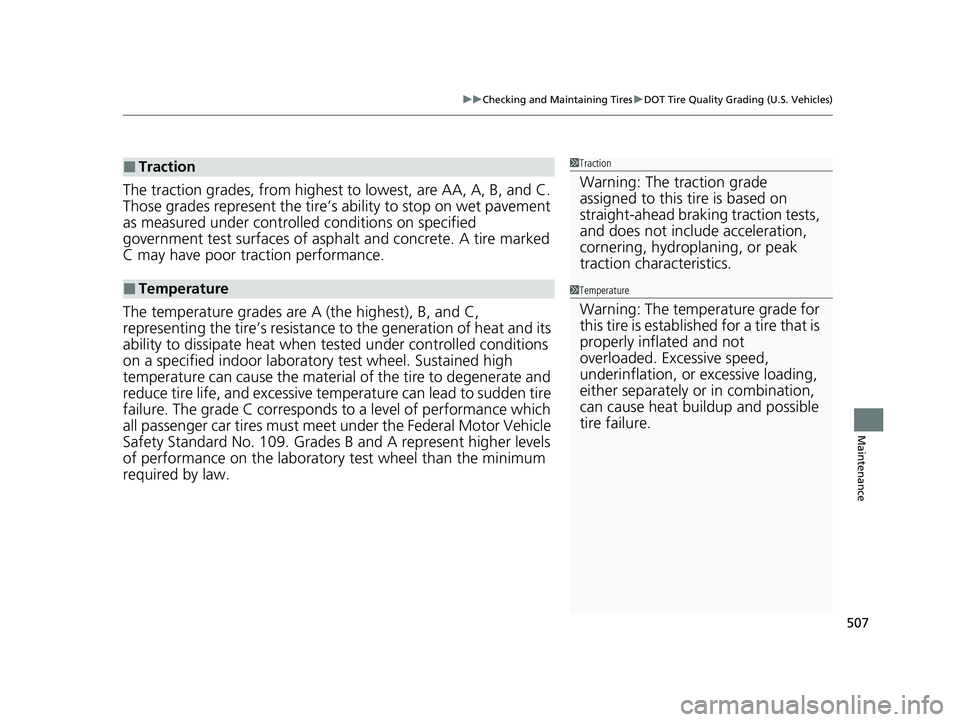Page 447 of 595

445
uuBraking uCollision Mitigation Braking SystemTM (CMBSTM)
Continued
Driving
The system has three alert stages for a possible collis ion. However, depending on circumstances, the CMBSTM may not go through all of
the stages before initiating the last stage.
■Collision Alert Stages
Distance between vehicles
CMBSTM
The sensor detects a vehicleAudible & Visual WARNINGSSteering WheelBraking
Stage oneThere is a risk of a
collision with the
vehicle ahead of you.
When in Long, visual and
audible alerts come on at a
longer distance from a vehicle
ahead than in Normal setting,
and in Short, at a shorter
distance than in Normal.
In case of an
oncoming vehicle
detected, rapid
vibration is provided.
—
Stage
twoThe risk of a collision
has increased, time to
respond is reduced.
Visual and audible alerts.—
Lightly
applied
Stage three
The CMBSTM
determines that a
collision is
unavoidable.
Forcefully
applied
Your Vehicle Vehicle
Ahead
Short
LongNormal
Your
Vehicle Vehicle
Ahead
Your
VehicleVehicle
Ahead
20 CLARITY PHEV-31TRW6200.book 445 ページ 2019年9月24日 火曜日 午後12時9分
Page 472 of 595

470
uuCharging uHigh Voltage Battery
Driving
High Voltage Battery
The High Voltage battery gradually discharges even if the vehicle is not in use. As a
result, if your vehicle is parked for an ex tended period of time, the battery level may
get low. Keeping your vehicle’s battery le vel low can shorten the battery life. To
maintain the battery while the vehicle is not in use, recharge the battery at least
once every three months.
The High Voltage battery life can also be affected by ambient temperature. In
particular, when it is cold outside, the ve hicle’s driving range on electric power can
be reduced, and a longer battery charging ti me is required. In addition, parking in
extremely hot or cold environments can accelerate battery drain.
To help extend the lifespan of the battery, it is recommended that you fully charge
the battery each time prior to driving.
Store the vehicle in a garage to insure that the temperature of the High Voltage
battery does not drop too low.
■Battery Warming System
Designed to prevent the temperature of the battery from dropping when outside
temperatures drop, thereby maintainin g starting and running efficiency.
If the vehicle is plugged in when outside temperatures are low, the battery warming
system will use the power from the charging equipment to maintain the
temperature of the battery until the next time the vehicle is driven.
1 High Voltage Battery
The High Voltage battery dr ains over time, and under
some conditions, drains fast er. When the battery life
is shortened, this cha nges the vehicle’s driving
distance.
Be careful not to let the High Voltage battery drain
too much. If the battery level becomes close to zero,
it will make it impossible to start the engine.
U.S. models
1 Battery Warming System
If the vehicle is left unplug ged in cold temperatures,
the temperature of the ba ttery will drop, possibly
resulting in a loss of running efficiency.
If left for an extended period of time in extremely
cold temperatures, the vehicle may not start. We
recommend that you plug in your vehicle when you
are parking or storing your vehicle in cold
temperatures.Canadian models
20 CLARITY PHEV-31TRW6200.book 470 ページ 2019年9月24日 火曜日 午後12時9分
Page 509 of 595

507
uuChecking and Maintaining Tires uDOT Tire Quality Grading (U.S. Vehicles)
Maintenance
The traction grades, from highest to lowest, are AA, A, B, and C.
Those grades represent the tire’s ability to stop on wet pavement
as measured under controlled conditions on specified
government test surfaces of asph alt and concrete. A tire marked
C may have poor traction performance.
The temperature grades are A (the highest), B, and C,
representing the tire’s resistance to the generation of heat and its
ability to dissipate heat when te sted under controlled conditions
on a specified indoor laboratory test wheel. Sustained high
temperature can cause the material of the tire to degenerate and
reduce tire life, and ex cessive temperature can lead to sudden tire
failure. The grade C corresponds to a level of performance which
all passenger car tires must meet under the Federal Motor Vehicle
Safety Standard No. 109. Grades B and A represent higher levels
of performance on the laboratory test wheel than the minimum
required by law.
■Traction
■Temperature
1 Traction
Warning: The traction grade
assigned to this tire is based on
straight-ahead braking traction tests,
and does not include acceleration,
cornering, hydroplaning, or peak
traction characteristics.
1Temperature
Warning: The temperature grade for
this tire is establishe d for a tire that is
properly inflated and not
overloaded. Excessive speed,
underinflation, or excessive loading,
either separately or in combination,
can cause heat buildup and possible
tire failure.
20 CLARITY PHEV-31TRW6200.book 507 ページ 2019年9月24日 火曜日 午後12時9分
Page 575 of 595
573
Information
Devices that Emit Radio Waves
Each radio frequency device installed in the vehicle conforms to the requirements
and standards of the regulation listed below:
As required by the FCC:
This device complies with Part 15 of the FCC rules. Operation is
subject to the following two cond itions: (1) This device may not
cause harmful interferenc e, and (2) this device must accept any
interference received, including interference that may cause
undesired operation.
Changes or modifications not ex pressly approved by the party
responsible for compliance could void the user’s authority to
operate the equipment.
This device complies with Industry Canada licence-exempt RSS standard(s).
Operation is subject to the following two conditions: (1) this device may not cause
interference, and (2) this device must acce pt any interference, including interference
that may cause undesired operation of the device.
20 CLARITY PHEV-31TRW6200.book 573 ページ 2019年9月24日 火曜日 午後12時9分